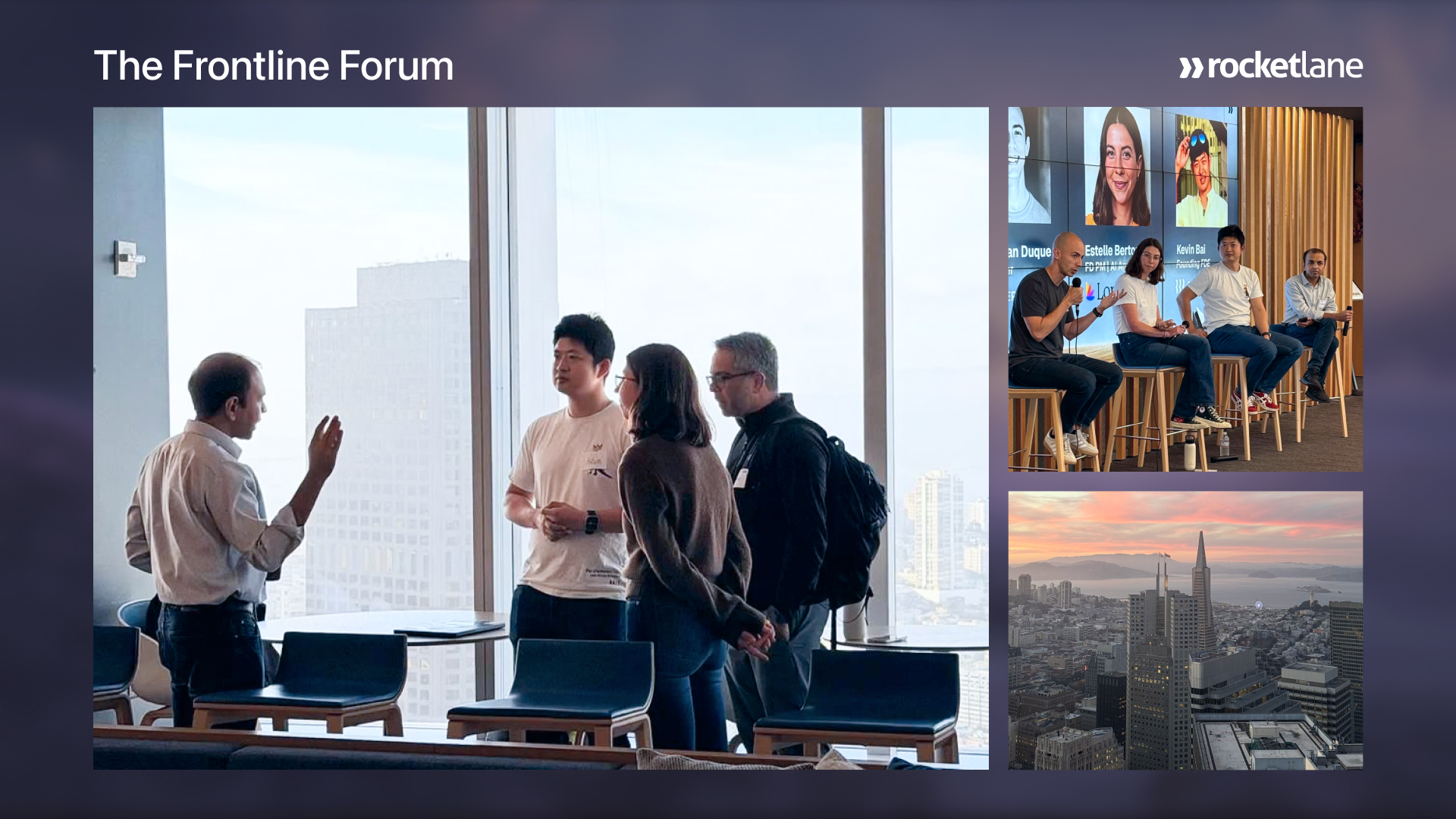The enterprise software landscape is shifting. As AI accelerates product complexity and customer expectations increase, the gap between what’s built and what’s adopted has never been wider.
How do companies close that gap?
Enter the Forward Deployed Engineer (FDE), a role quietly transforming how modern tech companies deliver outcomes.
At the second edition of the FDE Community Meetup hosted by the Frontline Forum, the only community dedicated to Forward Deployed Engineers, leaders from Intercom, Lorikeet, and Rippling joined Srikrishnan Ganesan, CEO and Co-founder of Rocketlane, to unpack how their organizations built, scaled, and monetized their FDE functions. The discussion revealed why this motion is fast becoming the new standard for high-impact customer delivery.
Why the FDE model exists
The story of Forward Deployed Engineering begins with a simple insight: customers who work closely with R&D teams see dramatically better results.
As Sebastian from Intercom shared, “When we launched Fin, our AI agent for customer service, we noticed something interesting: customers who engaged directly with our engineering and product teams got faster, higher-impact outcomes. So we built a function that brings R&D-level expertise to the frontlines.”
That insight became the genesis of Intercom’s FDE team, a cross-functional group of engineers, PMs, and data scientists embedded with customers and tasked with bridging the gap between technology potential and business value.
At Lorikeet, a startup in the AI support space, FDEs were part of the DNA. “We started with FDE from day one,” shared Estelle, Lorikeet’s Agent PM. “Our founders embedded themselves with the first customer for six months. That became our operating philosophy: build alongside customers.”
And for Rippling, a company with over 60 SKUs in its product suite, the FDE motion was born out of necessity. “We sell to large enterprises with complex needs,” said Kevin, Rippling’s founding FDE and former Palantir engineer. “When you have a technical product sold to non-technical buyers, they can’t self-implement. That’s when you need engineers who can bundle software and services to deliver value directly.”
What makes the FDE model different
The FDE model goes far beyond implementing software.
At its core, FDE is customer-embedded product development, a model where builders and operators coexist, and learning flows bidirectionally. FDEs, operating at the intersection of engineering, consulting, and customer success, enable customers to achieve business goals faster and funnel product learnings back to R&D.
For instance, at Intercom, a customer-specific integration that auto-ingested video transcripts evolved into a core analytics feature. At Rippling, a simple operational app built for one client became a reusable framework for multiple industries.
This pattern repeats everywhere: FDE work actively shapes what the product becomes.
How FDEs work across the customer journey
Unlike traditional delivery or implementation teams, FDEs collaborate end-to-end, from pre-sale scoping to post-sale adoption.
At Rippling, FDEs partner with sales to close enterprise deals that require tailored solutions. “Our job is to deliver what doesn’t yet exist, bridging the ‘we don’t sell this yet’ gap,” said Kevin. Once deployed, FDEs continue refining and productizing patterns alongside core product teams.
At Lorikeet, the structure is even more radical. There’s no separate implementation team. Instead, FDEs and PMs handle everything from integration design to product experimentation. “We share learnings daily, what worked, what didn’t. Redundancy in the early stages doesn’t scare us because it accelerates learning. Everything that repeats gets productized,” shared Estelle.
Intercom takes a hybrid approach with a dedicated FDE team for strategic accounts, working closely with both R&D and GTM teams. Some engagements are paid proof-of-concepts (POCs) while others are bundled into enterprise deals with defined milestones and exit criteria. This ensures FDEs are tied to commercial outcomes rather than engineering effort.
Rituals that keep the motion aligned
Embedding engineers in the field introduces challenges of coordination and consistency. How do you prevent duplication, inconsistency, or “hero engineering”?
Intercom relies on a culture of ritualized feedback loops through:
- Weekly team syncs with R&D
- Slack updates summarizing customer progress
- Biweekly all-hands demos to showcase learnings
Lorikeet extends this discipline further with documentation. The team uses Looms, Notion pages, and even internal GPTs to share successful configurations. “Every experiment has to be shared,” Estelle noted. “Once it repeats, it becomes part of the platform.”
Who makes a great FDE
FDEs are rare hybrids, part engineer, part founder, part consultant.
The best FDEs possess judgment, the ability to pinpoint what truly matters for the customer, and when to stop digging. As Sebastian described, “It’s about problem seeking, not just problem solving.”
Lorikeet’s approach to hiring reinforces this philosophy: every candidate goes through a paid two-day work trial. “We look for comfort with ambiguity, customer obsession, and communication clarity,” Estelle shared. “You’ll fail if you’re not energized by chaos.”
In short, the best FDEs are internal entrepreneurs who own outcomes end-to-end.
Avoiding the trap of custom solution sprawl
Without the right systems, embedding engineers with customers can easily create chaos and technical debt.
At Intercom, where dozens of custom builds run in production, Sebastian’s team tracks every change with a feature flag. Their rule: every test assumes the flag is “on” by default. That ensures code quality and test coverage remain uncompromised.
Rippling focuses on reusable primitives, small, modular building blocks that FDEs can compose into tailored solutions without introducing fragility. “Our FDEs write greenfield code,” Kevin said, “but it’s held to full engineering rigor, tests, CI/CD, reviews. And if customers want big changes, they pay for them. Maintenance is monetized.”
Lorikeet enforces this through clear principles: anything that doesn’t align with product vision is declined early.
The takeaway: Sustainability in FDE work depends on discipline, documentation, and monetization.
Making the business case: How FDEs prove ROI
Regardless of structure, every FDE initiative must tie directly to value creation, whether through revenue, retention, or engagement.
There are typically two models:
- P&L-bearing FDEs (like Rippling and Palantir) generate more revenue than they cost
- Non-P&L FDEs (like OpenAI’s deployment teams) are measured on adoption and usage uplift.
Some companies adopt a blended model with paid pilots for new initiatives that assign FDEs strategically for high-value accounts. Others treat every engagement as both a revenue driver and a learning engine that accelerates product maturity.
The future of the FDE role
As technology and enterprise complexity accelerate, the need for FDEs will persist. FDEs are becoming a core component of modern go-to-market and delivery strategies, with companies institutionalizing the function, doubling teams, and refining engagement models.
Like everything else, AI is already reshaping the FDE role.
“The best FDEs won’t be replaced by AI,” Kevin said. “They’ll be amplified by it.”
AI can handle repetitive setup tasks such as parsing APIs, mapping integrations, and even generating configuration code. But discovery, the act of deeply understanding a customer’s problem, remains profoundly human.
Rocketlane’s perspective: FDEs redefine how outcomes are delivered
At Rocketlane, we’ve always believed that the future of delivery lies in tighter collaboration between customer-facing teams and product builders.
The rise of FDEs validates that belief and represents a cultural shift towards accountability, velocity, and co-creation with customers.
As Srikrishnan Ganesan, Rocketlane’s CEO, summarized during the session:
“FDEs embody what modern delivery should look like, outcomes over output, empathy over process, and learning loops that strengthen both the customer relationship and the product itself.”
Rocketlane’s mission has always been to empower this kind of delivery, connecting teams, tools, and customers in one unified workspace that makes accountability, visibility, and velocity second nature.
For FDEs and leaders building similar motions, the challenge now is scale: how to preserve the closeness of field learning while standardizing excellence across teams. That’s where community and shared playbooks matter.
Join the conversation
The Forward Deployed Engineers Community, hosted by Rocketlane, brings together practitioners, leaders, and innovators shaping the next wave of customer delivery.
Whether you’re exploring the model, scaling your first FDE team, or just curious how AI will reshape delivery roles, this community is your space to learn, exchange ideas, and stay ahead of the curve.














